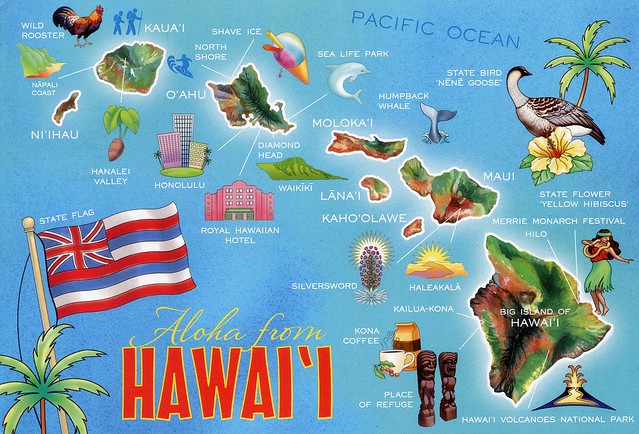A wonderful map card I received as part of a swap last year.
Hawaii is the 50th and most recent U.S. state to join the United States. It joined the Union on August 21, 1959. It is the only U.S. state located in Oceania and the only one made up entirely of islands. It is the northernmost island group in Polynesia, occupying most of an archipelago in the central Pacific Ocean.
Hawaii’s diverse natural scenery, warm tropical climate, abundance of public beaches, oceanic surroundings, and active volcanoes make it a popular destination for tourists, (wind) surfers, biologists, and volcanologists alike. Due to its mid-Pacific location, Hawaii has many North American and Asian influences along with its own vibrant native culture. Hawaii has over a million permanent residents, along with many visitors and U.S. military personnel. Its capital is Honolulu on the island of Oʻahu.
The state encompasses nearly the entire volcanic Hawaiian Archipelago, which comprises hundreds of islands spread over 2,400 km. At the southeastern end of the archipelago, the eight "main islands" are (from the northwest to southeast) Niʻihau, Kauaʻi, Oʻahu, Molokaʻi, Lānaʻi, Kahoʻolawe, Maui and the Island of Hawaiʻi. The last is the largest and is often called the "Big Island" to avoid confusing the island with the state or archipelago. The archipelago is physiographically and ethnologically part of the Polynesian subregion of Oceania.
Hawaii is the 8th smallest, the 11th least populous, but the 13th most densely populated of the 50 U.S. states. Hawaii's ocean coastline is about 1,210 km long, which is fourth in the United States after those of Alaska, Florida and California.
Hawaii is the only U.S. state not located in the Americas and the only state with an Asian plurality. It and Arizona are the only two states that do not observe daylight saving time, and Hawaii and Alaska are the only two states that are not in the contiguous United States.
Subscribe to:
Post Comments (Atom)





 Maroon
Maroon 










































































































































































No comments:
Post a Comment